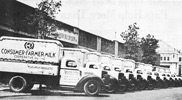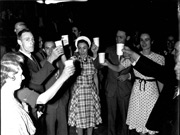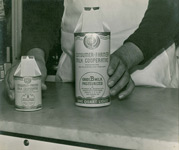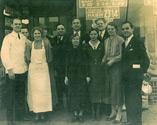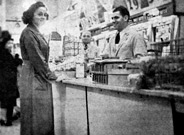At the first annual Consumer-Farmer Milk Cooperative Board of Directors meeting on November 28, 1938, the Secretary reported that the Co-op was already a success: "Beginning with 26 store agencies, 2020 members, and a sales volume of 9,386 quarts for the first month of operations, the Co-op was able to show a substantial increase to 298 agencies, 7,154 members and sales of 201,685 quarts of milk for October 1938."29 At the second annual meeting in 1939, the Secretary reported with satisfaction that, "We have not only met our obligations, but earned $6,345.86 during the fiscal year ended September 30, 1939. The sum of $4,730.35 has already been allocated to dividend and reserves and $2,285.92 is available as reserve for future dividends."30 Though exclusive sales of Grade B milk at the lowest possible price lowered dividend margins for the CFMC, Parodneck ingeniously made up for farmer’s low return with a device that quickly became a symbol of the Cooperative: the paper milk carton.
The CFMC unveiled their paper milk carton in the first edition of The Link, praising its convenience: "Lighter than bottles to carry (one weighs only 2 oz.); no washing; more sanitary; no exposed pouring surface; closed spout prevents entrance of bacteria and dust."31 The lightweight design also improved delivery efficiency. In 1943, Parodneck reported that a delivery route of 135 cases of paper cartons carried 2,700 quarts of milk, compared to the 1500 quarts carried by a bottle route of 125 cases.32 An emblem of Coop modernism, the paper carton's convenience and efficiency was celebrated on promotional material, newsletters and at fancy dress parties: a Co-op office manager once attended a League of Mother's Club Dance wearing "a green dress covered with Co-op literature, a necklace of vouchers, and on her head a ½ pint Co-op milk container."33 It was the perfect outfit to characterize the triumphant fulfillment of the CMFC's mission.
Parodneck and his Consumer-Farmer Milk Cooperative continued to give their members a voice until the 1970's when their mission was finally filled: milk was easily available and the dairy industry healthy. Meyer Parodneck sold the Cooperative and began a new phase of philanthropy: the Consumer-Farmer Foundation, an organization designed to offer low-interest and no-interest loans to help tenants rehabilitate dilapidated and abandoned housing. In celebration of his legacy, the Foundation was renamed the Parodneck Foundation for Self-Help Housing and Community Development in 1993, and continues his important work to this day.
"It is not our aim to "take over" milk distribution in our area. It is our aim to provide an outlet for milk for those producers who wish to have some "say" about the terms under which their milk is sold. And it is our aim to provide milk for those consumers who wish to have some "say" about the terms under which their milk is bought…let us raise our sights and plan courageously for the better world we all wish to see."- Meyer Parodneck

 introduction
introduction